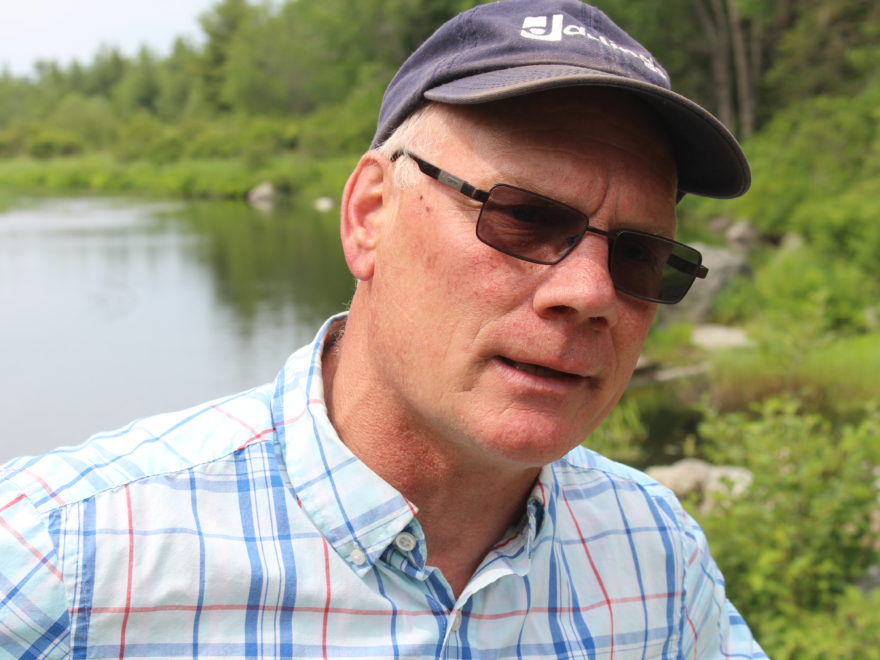How fast can the political pendulum swing? Ask Maine.
By Doug Struck Correspondent
July 17, 2019
WALTHAM, MAINE
Duane Jordan is a proud logger; so was his father and grandfather. But as the timber business slumped, Mr. Jordan figured he would put some of his land on the rugged Down East coast of Maine to good use by erecting 11 wind turbines to make electricity.
He couldn’t.
The governor of Maine for eight years, Republican Paul LePage, slapped a moratorium on wind turbines and viewed renewable energy, as one critic put it, as “an existential threat” to the state. He promoted fossil fuels, vetoed clean energy bills, tried to tear up environmental regulations, was alone among Atlantic coast governors to court offshore drilling, refused to issue voter-approved conservation bonds, and sought to tax vast protected forestland or open it to development. He also refused to put up signs to direct tourists to the Katahdin Woods and Waters National Monument designated by former President Barack Obama.
“He not only didn’t care about the environment, he was actively hostile toward it,” says a Democratic state senator, Brownie Carson.
Mr. LePage decamped the State House in January to move to Florida, after his frequent foil, Maine Attorney General Janet Mills, was elected. In the whirlwind legislative session that ended last month, the Legislature passed and Governor Mills signed an unprecedented array of environmental bills.
“Look at this,” says Pete Didisheim, the longtime lobbyist for the state’s chief environmental group, the Natural Resources Council of Maine. At his sun-lit office in Augusta, he spreads out a three-page list of environmental bills that were before the Legislature. In the right column next to 56 of the bills is a legislative result in green ink: “WIN, WIN, WIN, WIN …” reads the column.
Mr. Didisheim has a huge grin. “Hands down, this was the most productive session for the environment and clean energy in my 23 years,” he says. “Not just 23 years,” he corrects. “Ever.”
Environmentalists nationwide have perked up at Maine’s dramatic six-month turnabout. Some see it as a teaser for what might happen federally whenever the Trump administration leaves and the president’s efforts to roll back environmental safeguards ends.
“Maine’s progress suggests a model for the rest of the country,” says Andre Delattre, a senior vice president for the environmental group Public Interest Network, from Chicago.
“There are parallels” between Maine and the federal scene, says Elizabeth Gore, senior vice president for political affairs at the Environmental Defense Fund in Washington. “Paul LePage was a Trump-like leader who worked against the pro-environmental consensus of the state. Donald Trump is doing the same thing at the federal level. That creates a pent-up demand for legislative action.”
Nationally, there are “more diverse interests, regional politics, and partisan politics” than in Maine, she notes. But “Maine did it the right way. Maine was able to build on bipartisan majorities. We see that as a critical part of a federal strategy as well.”
Maine moved fast with trifecta Democratic control of the House, Senate, and governor’s office. The Legislature pledged to nearly eliminate carbon dioxide emissions by 2050, expand solar and offshore wind, promote electric vehicles, and distribute 100,000 heat pumps. It became the first state to ban foam food containers and the third to ban single-use plastic bags. It also prohibited offshore oil and gas drilling, stiffened river and lake water protections, threw out Mr. LePage’s appointees, and established a new office to help plan for climate change.
“Maine has a strong history of environmental protection and regulation” that has often been bipartisan, notesSandy Maisel, a professor of American government at Colby College in Waterville, Maine. “But some of the Republicans were pretty much silent for the last four or five years.” Now, “the Republicans who worked in lockstep with LePage are not opposing Mills.”
Bipartisan environmental legislation sent to Mr. LePage during his terms was quickly rejected. He vetoed 642 bills during his tenure, exceeding the total of all his predecessors for 100 years.
With no vetoes to override, Republicans joined their colleagues and environmental bills flew out of committees with unanimous votes. “Some of [the Republicans] switched and some of them know when the momentum is headed in a different direction,” says Hannah Pingree, who heads the state’s new Office of Innovation and the Future. “There was quite a bit of pent-up demand.”

Duane Jordan proposed erecting 11 wind turbines on his property near Waltham, Maine, but could not get approval for them until the new governor took office this year. Photo by Doug Struck
And five months after Governor Mills took over, Mr. Jordan got approval to go ahead with his 11 wind turbines.
“This will be where Turbine 8 will be,” Mr. Jordan says, stabbing a stake at a granite ledge on top of Little Bull Hill, a bluff overlooking a rolling green carpet of forestland stretching 20 miles to the ocean. Construction of the 600-foot-high turbines would begin in a week, he says.
Mr. LePage – who boasted he was “Donald Trump before Donald Trump” – treated environmentalists, union activists, and rights campaigners as an anathema. His explosive, often profane rages directed at opponents were legend.
Mr. Jordan, with a more typical Mainer’s restraint, said he thought Mr. LePage was not a bad guy. He credits the governor for coming out to the forests in Eastbook, near Waltham, to look at both his logging and his potential turbine sites on a rainy, muddy day in 2016.
“He was tough on wind,” Mr. Jordan says, while jostling up a gravel logging road in his pickup truck. But Mr. LePage was the kind of governor that Mr. Jordan felt was permissible to call on the phone one day and say, “Mr. LePage, you’ve screwed up my wind project.”
Matt Kearns, the developer who teamed with Mr. Jordan and a neighbor to propose 22 turbines and sell the energy to the local utility, says he spent “several million dollars” on the project before putting it on hold in 2015 to await more receptive state officials.
“We didn’t feel we were in a position to have a thoughtful dialogue with them,” says Mr. Kearns.
In a century-old brick dock building in Portland, Maine, Mr. Kearns’ Longroad Energy runs a Remote Operations Center that electronically tends to 499 wind turbines in five states and nearly as many solar installations in another 19 states. Technicians in the darkened center watch a march of data on a dozen monitors round-the-clock for signs of blown fuses, broken connectors, or malfunctioning inverters that sap energy production. Despite the company’s reach, none of the wind turbines and only one solar field are in its home state of Maine.
“It was like night and day when the new administration came in. There was a willingness to have a discussion about science and economics and conservation” of renewable energy, Mr. Kearns says.
“We have crossed the Rubicon,” adds Jeremy Payne, executive director of the Maine Renewable Energy Association. “Governor Mills absolutely deserves credit for this. She made clear that this is going to be a priority for her. A lot of these ideas were kind of teed up and ready to go.”
Not everyone is thrilled that the surge of legislation – on the environment, health care, and several other areas – was enacted so quickly. “When you have one-party rule in any legislative body, you have a lot of voices that are not heard,” cautions state Sen. Matt Pouliot, a Republican. Some of the fiscal moves were “an affront to the business community.”
But Senator Pouliot acknowledges that after the tempestuous years of Mr. LePage, “this legislative session was more subdued and civil.” Some see in that change, and in the flood of environmental policy changes, a precursor for the nation.
“I do see it as a model,” says Kathleen Meil, director of policy for the Maine Conservation Voters in Augusta. “I think what we have seen in LePage in Maine, and Trump at the national level, is out of step with public expectations for climate leadership. When the barrier is removed, the window of opportunity will be there at the federal level, just as it was in Maine.”
Jamie Demarco, who works for the Citizens’ Climate Lobby in Washington, agrees: “When you see a rising tide at the state level, it’s often followed by meaningful action in Congress.”
Story appeared at: https://www.csmonitor.com/Environment/2019/0717/How-fast-can-the-political-pendulum-swing-Ask-Maine
